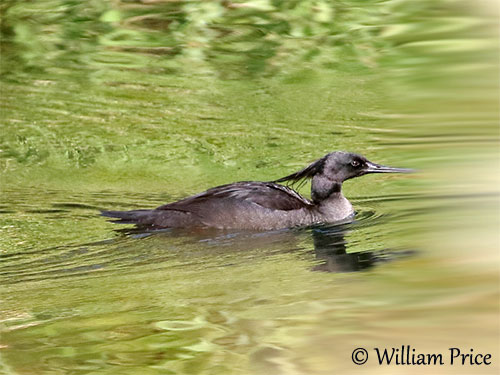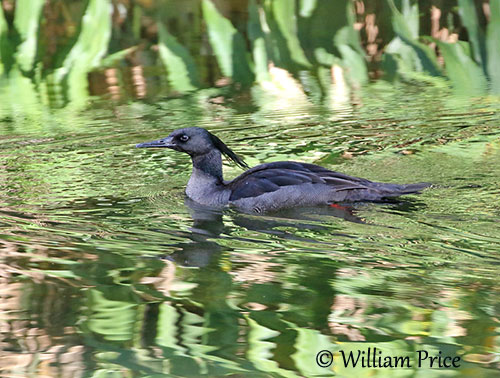
Fr: Harle huppard
Ang: Brazilian Merganser
All: Dunkelsäger
Esp: Serreta Brasileña
Ita: Smergo del Brasile
Nd: Braziliaanse Zaagbek
Sd: cerradoskrake
Photographers:
Jean Michel Fenerole
Photos d’Oiseaux du monde
William Price
PBase-tereksandpiper & Flickr William Price
Dubi Shapiro
Dubi Shapiro Photo Galleries
Text by Nicole Bouglouan
Sources:
HANDBOOK OF THE BIRDS OF THE WORLD vol 1 by Josep del Hoyo-Andrew Elliot-Jordi Sargatal - Lynx Edicions - ISBN: 8487334105
Ducks, Geese and Swans: Species accounts (Cairina to Mergus) published par Janet Kear – Editeur: Oxford University Press, 2005 – ISBN: 0198610092, 9780198610090 – 908 pages
GUIDE DES CANARDS, DES OIES ET DES CYGNES – de Steve Madge - Delachaux et Niestlé - ISBN: 2603013769
Brazilian Merganser Recovery Project
New observations on the Brazilian Merganser
Arthur Grosset's Birds (Arthur Grosset)
Wikipedia, the free encyclopaedia
Brazilian Merganser
Mergus octosetaceus
Anseriformes Order – Anatidae Family
INTRODUCTION:
The Brazilian Merganser is one of the world’s rarest species. This dark, slender duck has a long crest, usually shorter in female. It was formerly widespread in SC Brazil and adjacent regions, but it has now a much more restricted range. The main population is found in the Serra de Canastra region, but its range is very fragmented.
The Brazilian Merganser is found in remote and mountainous regions where it occurs in rivers and streams with rapids, bordered by forests or native vegetation. In this type of habitat, it feeds mainly on small fish caught while diving, which is why it is often compared to a cormorant (Family Phalacrocoracidae). Its behaviour is also reminiscent of that of the Torrent Duck - Merganetta armata.
This species is very territorial and the pairs often occupy permanent territories. It nests in cavities in trees or in rock crevices, and even in abandoned burrows. The female incubates alone but both parents feed and rear the young.
The Brazilian Merganser is a rare bird with less than 250 mature individuals. It is threatened by degradation of the habitat, through destruction of riparian forests and degradation of river banks, and also use of pesticides involving permanent water pollution.
The species is currently listed as Critically Endangered.

DESCRIPTION OF THE BIRD:
Biometrics:
Length: 49-56 cm
Weight: M: 800 g – F: 700 g
The Brazilian Merganser adult male has greyish-brown back. Tail and upperwing are blackish with a white wing patch well visible in flight or when the bird is resting or swimming. The white secondaries have black bases, like the greater secondary coverts. The black bases form a dark wingbar on the white wing patch.
On the underparts, the breast is pale grey with narrow, darker grey vermiculations. Rest of underparts become paler towards belly and vent.
On the dark head and neck, metallic dark green reflections are seen, especially in good light. The long, occipital crest is dark grey to blackish.
The long, sharp-edged bill is black, with numerous teeth-looking expansions. The eyes are dark brown. Legs and webbed feet are red.
The female is similar to the male, but she is slightly smaller with shorter crest.
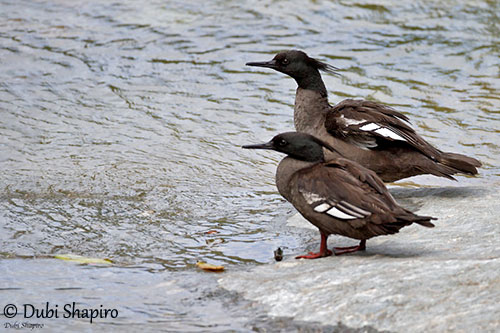
The immature has grey back like adult, and the wingbar is present. The breast is greyish.
On the head, the crest is absent. Cheeks and neck are whitish, and the eyes are surrounded by a white eyering. The bill has dark upper mandible and reddish lower mandible. Legs and feet are red.
RANGE:
The Brazilian Merganser was originally present in SC Brazil and adjacent Paraguay and Argentina. But currently, the population is located in Brazil, especially in the Serra de Canastra, where it is highly fragmented. A more recent population (2002) has been found in Argentina, on the Arroyo Uruzu in Misiones.
HABITAT:
The Brazilian Merganser is usually found in remote mountainous areas where it frequents shallow, transparent fast-moving waters.
It avoids human presence, although it may occur close to villages and small towns. It has adapted to degraded habitats if there are well preserved areas where the bird can seek shelter.
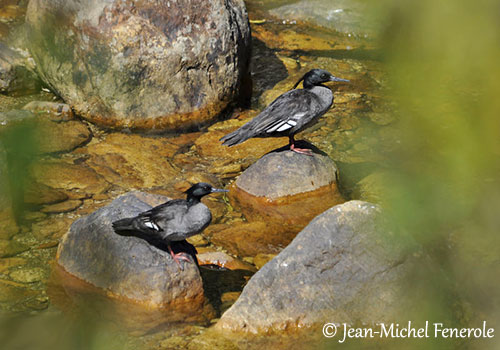
CALLS AND SONGS: SOUNDS BY XENO-CANTO
The Brazilian Merganser is known for its common call similar to a dog’s bark. The alarm call is a harsh “crock-crock” only given in flight. We can also hear a soft “rak-rak-rak” as contact call.
Both mates often vocalize. The female’s call is a raucous “rrr-rrrrr”. The ducklings utter high-pitched “ik-ik-ik”.
BEHAVIOUR IN THE WILD:
The Brazilian Merganser feeds primarily on small fish caught by diving, but it also consumes molluscs, aquatic invertebrates and insects flying close to its head. When fishing, the duck swims with submerged head while searching for prey. Then, it dives in fast-flooding rivers, but also in backwater.
It may also forage in deeper water, diving for 10 to 30 seconds. The fish generally measures 6-19 centimetres.
They often fish in pairs, mainly in the morning and the evening. They rest during day and night, perched on stones, branches and fallen trees on or near water, and on river beaches.
If threatened, the duck goes immediately into the water. There, it swims quickly, down or up stream, or takes off to fly away.
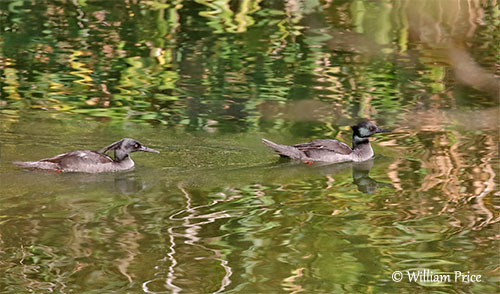
The Brazilian Merganser is monogamous and both mates remain together for a long time or even for life.
The courtship displays take place in the water. The male chases the female or both adults move around in circles while paddling strongly with the wings.
The copulation is typical of the Anseriformes. The female lowers the head and extends her body horizontally. The male mounts her, grasping her crest with the bill. The copulation may last 15-25 seconds.
The pair remains on the territory year-round. They are highly territorial and fights with neighbours may occur.
The young are fed and protected by both parents.
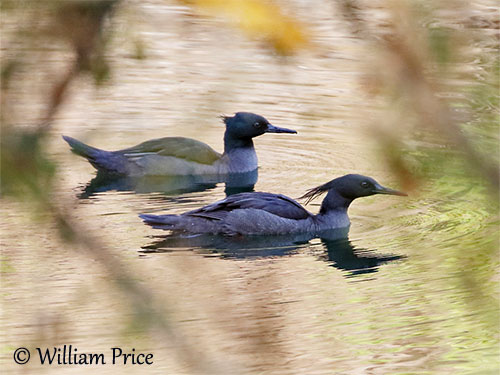
The Brazilian Merganser is sedentary and does not migrate.
This species flies fast close to the water surface, and usually following the river course. It may also fly higher, about 20 metres high. The Brazilian Merganser is more agile on land than other Mergus species, and it is able to climb waterfalls easily.
However, the adults never fly if they are accompanied by flightless young. If threatened, they attempt to escape by reaching the vegetal cover along the shore, or by swimming quickly away.
The young are maintained between the adults and constantly guarded. The young are able to pass easily through rapid waters.
REPRODUCTION OF THIS SPECIES:
The breeding season takes place from June to September. The pair remains in the permanent territory of 8 to 17 kilometres stretches of rivers.
The Brazilian Merganser nests in rock crevices, hollows in trees or abandoned burrows made by Armadillos, and the nest is built inside the cavity. The entrance is located from 2 and 25 metres above the water.
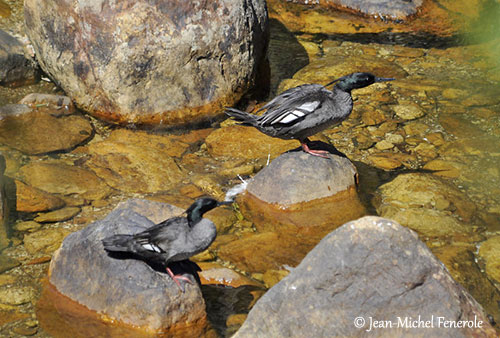
The female lays 3-8 almost white eggs in June/July, and the chicks hatch in July/August. The female incubates alone during about 32-34 days. She usually leaves the nest twice per day to feed. When the female leaves the nest, she covers the eggs with her down feathers. During this period, the male rests or feeds nearby and remains constantly vigilant.
The chicks leave the nest 24 hours after hatching, encouraged by the calls of their mother. They are black above with white patches on wings, flanks and rump. There is a fine white line from lores to beneath the eye, and a small white spot in front of the eye. The bill is black. The eyes are grey. Legs and feet are dull grey with black webs.
Both parents care for the young and feed them with fish and invertebrates. The adults feed them into the bill, but they also may place the fish in the water and shake it to entice the young to catch it. They are able to forage and feed themselves about 10 days later.
They can perform short flights when 2 months old. They remain in family group during about 6 months, sometimes longer, up to 8 or 10 months.
They are protected by the adults and remain between their two parents while swimming and moving.
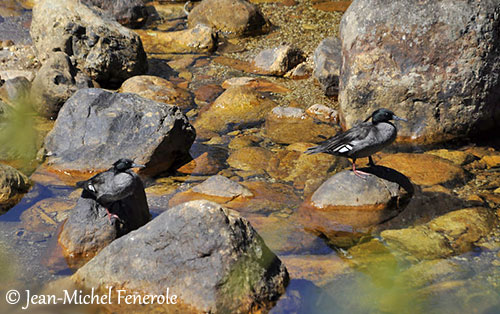
PROTECTION / THREATS / STATUS:
The Brazilian Merganser has small, fragmented population scattered through the restricted range in SC Brazil.
The habitat required by this species has suffered from heavy deforestation and permanent flooding from dams. Even in Serra de Canastra National Park where these ducks are most numerous, a series of forest fires devastated this area.
The limited range of the Brazilian Merganser, added to a very specific habitat requirement, suggest a small population (fewer than 250 mature individuals). This species is highly vulnerable to habitat degradation and human pressure, and the survival depends on strictly protected areas within the very restricted original range.
The small population is suspected to have declined rapidly over the last twenty years. Conservation actions are underway to help this beautiful duck recover. The Brazilian Merganser is currently listed as Critically Endangered.
